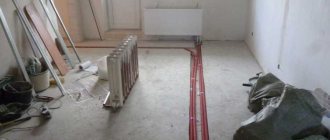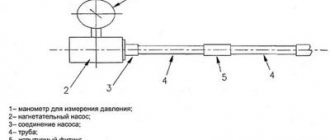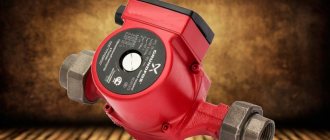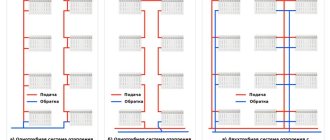A heating element (tubular electric heater) is a device for heating the working environment to medium temperatures. This is a thin-walled metal, ceramic or glass tube, inside of which there is a spiral or heating filament located in the center. As a rule, the spiral or thread is made of nichrome alloys, which ensures the durability of the device and heats the environment to sufficiently high temperatures in a uniform manner.
At the ends of the heating element there are special contact rods that are connected to the electrical network.
What types of heating elements are there for heating?
Devices can be divided into several types - it all depends on the classification option:
- air, water - by type of working media;
- tape, tubular, as well as ribbed and rod type - according to the type of heated surfaces;
- for heating boilers, boilers, electric stoves, heating radiators - according to application options.
Some types are equipped with temperature control devices and automatic shutdown sensors in case of overheating.
Heating elements for heating can be selected according to the optimal power for a particular case.
Installation of heating installations is carried out regardless of how the electric heater will be used (inside a heating boiler, in infrared heaters). They can be used for heating garages and utility rooms.
Two-pipe system with bottom wiring
Next, we will consider two-pipe systems, characterized by the fact that they ensure uniform heat distribution even throughout the largest households with many rooms. It is the two-pipe system that is used for heating multi-storey buildings, in which there are a lot of apartments and non-residential premises - here this scheme works great. We will consider schemes for private houses.
Two-pipe heating system with bottom wiring.
A two-pipe heating system consists of supply and return pipes. Radiators are installed between them - the radiator inlet is connected to the supply pipe, and the outlet is connected to the return pipe. What does this give?
- Uniform heat distribution throughout the rooms.
- Possibility of adjusting the temperature in the rooms by completely or partially closing individual radiators.
- Possibility of heating multi-storey private houses.
There are two main types of two-pipe systems - with bottom and top wiring. First, we will look at a two-pipe system with bottom wiring.
Bottom wiring is used in many private homes, as it makes heating less visible. The supply and return pipes pass here next to each other, under the radiators or even in the floors. Air is removed through special Mayevsky taps. Heating schemes in a private house made of polypropylene most often provide for just such wiring.
Advantages and disadvantages of a two-pipe system with bottom wiring
When installing heating with bottom wiring, we can hide the pipes in the floor.
Let's see what positive features two-pipe systems with bottom wiring have.
- Possibility of masking pipes.
- The ability to use radiators with bottom connections makes installation somewhat easier.
- Heat losses are minimized.
The opportunity to at least partially make heating less visible attracts many people. In the case of lower wiring, we get two parallel pipes running flush with the floor. If desired, they can be placed under the floors, having provided for this possibility at the stage of designing the heating system and developing a project for the construction of a private house.
If you use radiators with bottom connections, it becomes possible to almost completely hide all the pipes in the floors - the radiators are connected here using special units.
As for the disadvantages, they are the need for regular manual removal of air and the need to use a circulation pump.
Features of installing a two-pipe system with bottom wiring
Plastic fasteners for heating pipes of different diameters.
In order to install a heating system according to this scheme, it is necessary to lay supply and return pipes throughout the house. For these purposes, there is a special plastic fastener on sale. If radiators with a side connection are used, we make a branch from the supply pipe to the upper side hole, and take the coolant through the lower side hole, directing it to the return pipe. We install air vents next to each radiator. The boiler in this scheme is installed at the lowest point.
It uses a diagonal connection of radiators, which increases their heat transfer. Bottom connection of radiators reduces thermal output.
This circuit is most often made closed, using a sealed expansion tank. The pressure in the system is created using a circulation pump. If you need to heat a two-story private house, we lay pipes on the upper and lower floors, after which we create a parallel connection of both floors to the heating boiler.
Purpose of heating elements for heating
The devices have become widespread due to their high efficiency. The main heating devices that use heating elements include:
- electric oil heaters - both stationary and mobile;
- water-type heating radiators;
- towel dryers;
- electric fireplaces;
- electric convectors;
- electric boilers.
Despite the fact that certain rules must be followed during operation, no special skills are required for installing these heating heating devices.
Operating principles of heating elements for heating
Almost all heating elements operate on the same principle. When the element is connected to the electrical network, the spiral or filament is heated due to the thermal effect of the electric current. Between the spiral and the inner wall of the tube there is a special current-insulating substance that conducts thermal energy well, so first the heat from the spiral or filament is transferred to this substance, from it to the tube body, and then to the coolant.
If we are talking about the use of liquid coolants (oil or water), then convection currents are formed around the tube, mixing the coolant and promoting its uniform heating.
Electric heating boilers are reliable and maintainable. They do not contain a large number of complex elements, so they are easy to use in everyday use.
Liquid-free heating devices usually have a heating temperature limitation. This is necessary to ensure that the heat energy does not damage the device and cause a fire. In addition, such devices often have built-in fans that provide convection mixing of warm and cold air flows, speeding up the heating process.
Thermal accumulator
The device serves to organize economical heating, warms up during the period of minimum electricity prices, usually at night, and releases heat when the heating is turned off during the day.
Here is the answer to the question of how to heat a house with electricity inexpensively. Diagram of connecting a heat accumulator to the heating system in a house.
Manufacturing Features
It is a tank of water covered with thermal insulation material. Sometimes paraffin is used instead of water, but such batteries are more expensive and warm up to a lower temperature, although they store more heat.
Principle of operation
When the heating system operates, the water in the tank warms up. Sometimes directly, sometimes through a radiator passing through the tank. When the heating is turned off, the heat accumulated in the tank warms the batteries. The easiest way is when water from the tank directly flows into the radiators. For more expensive models, an automatic system is provided that connects the water inside the tank to the heating system only after the batteries have warmed up. This is done in order to quickly warm them, and, as a result, the apartment.
Do-it-yourself heat accumulator
The design of a heat accumulator is very simple, so it’s not difficult to make it yourself. For this you need:
- A container that is hermetically sealed. You can use a metal barrel.
- Two fittings for metal-plastic water supply. Fittings are required to have a male thread on one end.
- Two valves. If you purchase valves with built-in fittings, you do not need to buy them separately.
- Mayevsky valve for air release. If you plan to use the battery as a boiler, then the Mayevsky tap is not installed. Instead, you need two more valves, two fittings and threads with nuts to secure the valves to the barrel.
Thermal insulation material sufficient to insulate the barrel.
The process itself consists of several stages:
- Holes are cut in the barrel for fittings and the Mayevsky tap, two in the very top and one in the very bottom.
- Fittings are inserted into the holes and secured.
- The Mayevsky tap is inserted into the top hole and also secured.
- Valves are screwed onto the fittings, pipes are connected to them - from the boiler and cold water from below, to the radiators and hot water outlet - from above.
- Wrap the barrel with a heat insulator.
- When the system is filled with water, air is released through the Mayevsky tap or hot water in the shower.
Heating elements for heating aqueous media
These types of heaters are most often found in heating appliances. These are autoclaves, boilers, oil and water radiators. As a rule, the heating temperature here is limited to 90 degrees Celsius. Very rarely there are models that allow water to be heated up to 100 degrees.
If there is a need to increase the power of the heating device, then block heating elements are installed inside it. However, the equipment cannot always operate from standard household electrical networks.
To prevent moisture from getting inside the device, the heater is waterproofed at the ends. In this case, the rods for electrical contacts are additionally surrounded by dense insulating shells made from an electrically insulating substance.
Pros and cons of heating your home with electricity
Heating a private home with an electric boiler has many undeniable advantages:
- Ease and simplicity of installation work.
- Installing the system does not require the use of complex and expensive tools. You can install electric heating in your own home yourself. The equipment is not large in size, is installed at minimal cost, and equipment already in use can be easily transported and moved to different rooms. There is no need to install a separate boiler room and chimney.
- Safety.
- When operating electric heating systems, no harmful emissions are generated due to the complete absence of combustion products. Neither materials nor equipment contain any harmful substances.
- Low costs.
- There is no need to prepare and develop project documentation, invite special services, and no permits are required.
- Quiet and reliable operation.
- Properly made electric heating does not require any maintenance by third-party specialists. The equipment is characterized by quiet operation due to the absence of a circulation pump and fan.
- Easy to use.
- There are no quickly wearing elements in the system; there is no need to monitor the fuel level and pressure sensors.
- High efficiency.
- The ability to quickly heat and warm up the house even during the most severe frosts. The system is equipped with special equipment with which the temperature in each room is regulated, which also allows optimizing costs during the heating season.
Flaws:
- Significant energy consumption.
- This is the main disadvantage, since the cost of electricity is quite high. In some areas, this method of heating a home may be completely impractical and unprofitable.
- Dependence on external energy supply.
- If for any reason the electricity is turned off, heating will be impossible.
- Susceptibility to voltage fluctuations in the network.
This is often typical in rural areas. The problem can be solved by purchasing a generator, but this will also increase costs significantly.
Each of the considered types of electric heating has its own advantages and disadvantages, which should definitely be taken into account if you want to arrange a good heating system for your own home. In any case, you should think about insulating a house at the design stage, since the efficiency and economy of heating using electricity largely depends on this.
Flexible heating elements
Flexible heating elements are most often used in hot runner systems. They are convenient because they can be bent. This ensures both uniform heating of the working environment and optimization of the internal location of the heater inside the device.
The industry produces many standard sizes of flexible heaters, which, when assembling a specific electrical appliance, are placed inside a special groove. Heating heating elements that are designed for underfloor heating systems deserve attention. They have a second name - heating cables. A subtype of heating cable is a self-regulating cable.
Tubular heating elements for heating radiators
It is recommended to buy assembled heating elements equipped with control devices only if you are completely sure that the cord has the required length.
This type of tubular heating heaters may vary in shape and length. Everything will depend on the design features of the device for which the heating element is intended. The most common technical characteristics for them:
- tube diameter – from 5 to 18 mm;
- tube length can vary from 200 to 6,000 mm;
- tube manufacturing materials - various types of steel, including stainless steel, as well as copper and ceramics;
- power – from 0.3 to 2.5 kW.
There are also more powerful heating elements, but they are not installed in household heating appliances, because Home electrical wiring is not designed to handle high loads.











